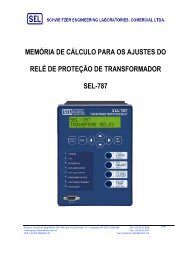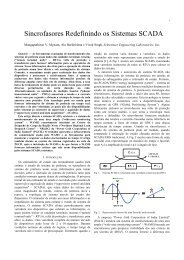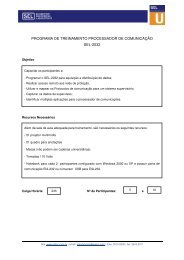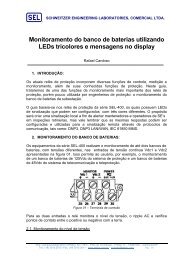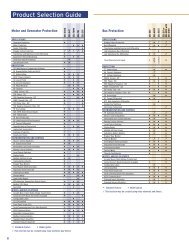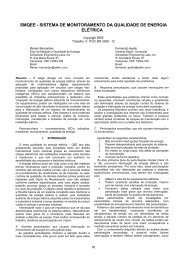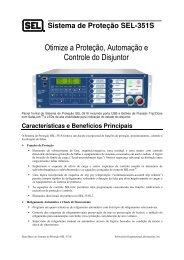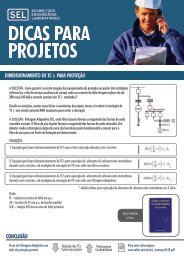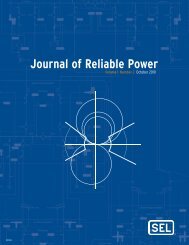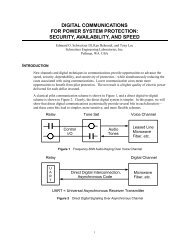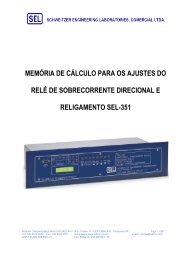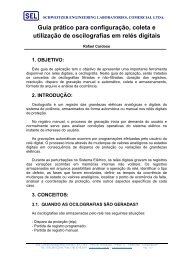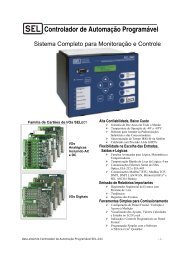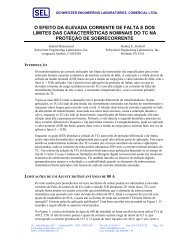Journal of Reliable Power - SEL
Journal of Reliable Power - SEL
Journal of Reliable Power - SEL
Create successful ePaper yourself
Turn your PDF publications into a flip-book with our unique Google optimized e-Paper software.
The most onerous 3φ fault is one with the following<br />
qualifications:<br />
1. A small critical amount <strong>of</strong> fault resistance.<br />
2. Significant load flow into the bus from a weaker<br />
source.<br />
Three-phase faults are a concern to phase distance elements<br />
only after the memory expires. For bolted faults, each phase<br />
voltage is zero. Once the memory expires, the distance<br />
elements are disabled. However, with some resistance, the<br />
polarization voltage does not go to zero, and could move to an<br />
angle permitting tripping.<br />
Figure 11(a) illustrates a system with a reverse 3φ fault<br />
with fault resistance. Figure 11(b) shows the total Aφ fault<br />
current (I F,a ), the prefault memory voltage (V a,mem ), Aφ voltage<br />
and current seen by the relay (V af and I RLY,a respectively), and<br />
I RLY,a adjusted by the replica line impedance.<br />
Recall the denominator term <strong>of</strong> Equation 1 for a phase<br />
distance element. This denominator term is a directional<br />
element. It indicates how a phase distance element <strong>of</strong> infinite<br />
reach would perform for this same fault. If the angle between<br />
Z • I and V p is less than 90°, the phase distance element<br />
declares the fault forward. From Figure 11(b), the angle<br />
between I RLY,a • Z and V a is less than 90°. Thus, after the<br />
memory voltage (V a,mem ) becomes in step with V af , the<br />
directional security <strong>of</strong> the phase distance element is<br />
compromised.<br />
Figure 11(c) illustrates the same reverse 3φ fault with load<br />
flowing out from the relay terminal (from E S towards E R ). For<br />
this case, the phase distance relay is secure even after the<br />
memory voltage becomes in-step with the fault voltage.<br />
Solutions:<br />
1. Clear the 3φ fault before the memory expires.<br />
2. The apparent impedance for the reverse 3φ-G fault<br />
enters the tripping characteristic in the secondquadrant.<br />
Reducing the maximum torque angle<br />
reduces the amount <strong>of</strong> second-quadrant coverage.<br />
3. Require an increased torque magnitude output from<br />
the comparator (i.e., desensitize the element). As the<br />
apparent impedance enters the tripping characteristic<br />
very near the origin, forward direction 3φ faults<br />
produce greater torques than do the reverse 3φ faults.<br />
4. Add current <strong>of</strong>fset in the positive direction to the<br />
polarizing reference.<br />
5. Test the angle between the positive-sequence current<br />
and voltage (i.e., use a positive-sequence directional<br />
element). This angular test limits the three-phase fault<br />
coverage to a 180° impedance angle sector <strong>of</strong> –120° to<br />
60°.<br />
VII. LOAD ENCROACHMENT<br />
The impedance <strong>of</strong> heavy loads can actually be less than the<br />
impedance <strong>of</strong> some faults. Yet, the protection must be made<br />
selective enough to discriminate between load and fault<br />
conditions. Unbalance aids selectivity for all faults except<br />
three-phase faults.<br />
Figure 12 shows the load-encroachment characteristics in<br />
the impedance plane.<br />
Figure 11:<br />
Reverse 3φ Fault Conditions and Mho Element Performance<br />
Figure 12: Load Encroachment on Mho Distance Element Characteristics<br />
When power flows out, the load impedance is in the<br />
wedge-shaped load-impedance area to the right <strong>of</strong> the X-axis.<br />
When power flows in, the load impedance is in the left-hand<br />
load-impedance area.<br />
There is overlap (shaded solid) between the mho circle and<br />
the load areas. Should the load impedance lie in the shaded<br />
area, the impedance relay will detect the under-impedance<br />
condition and trip the heavily-loaded line. Such protection<br />
unnecessarily limits the load-carrying capability <strong>of</strong> the line.<br />
For better load rejection, the mho circle can be squeezed<br />
into a lenticular or elliptical shape. Unfortunately, this also<br />
reduces the fault coverage.<br />
Distance Relay Element Design | 11



